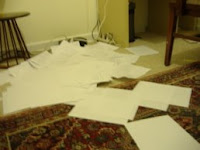If you’ve ever had a conversation with me for, say, longer than three minutes, or attended the workshop Pam Rosenthal and I occasionally give, Writing the Hot Historical (or, as we call it, Pam and Janet Evening) you will have heard it:
The Rant About the Pebbled Nub.
Worse, it has spread from above the waist to below the female belt (if you know what I mean and I think you do) so that each heroine potentially has three of the darned things for the hero to lave. And that’s another one. Lave? Is something wrong with the good, old-fashioned, venerable and in-your-face lick, derived from the Old English liccian? Why resort to a Latin-based word? Latin lovers may be sexy, generally Latin-based words convey the opposite; just one of those strange English-language things. (Lave is next on the hit list.)
But let us return to the pebbled nub: 1594, variant of dialectal knub, probably a variant of knob: 1373, knobe, probably from a Scand. or Ger. source (cf. M.L.G. knobbe “knob,” O.N. knyfill “short horn”). Meaning “knoll, isolated round hill” is first recorded 1650, especially in U.S.
Then there’s the equally overused nubbin (ugh): “dwarfed or imperfect ear of corn,” 1692, Amer.Eng. dim. of nub.–to my ear it somehow suggests a piece of sewing equipment, like bobbin.
But it’s not the word’s origins I take exception to, it’s the use and misuse, the kneejerk laziness inherent in using a term that has long since lost its impact. The counter argument is that everyone knows what a pebbled nub (or nubbin) is; it’s a familiar reference term, a landmark on the way to the HEA. It keeps the story going. It doesn’t pull (most) readers out of the moment and the building sexual tension. In other words, within the context it works, or it can work. Substitute a stupendous and original metaphor and the reader will stop, ponder, gasp in awe and lose the flow. I think there has to be a solution. Instead of relying on tired old cliches, it’s our job as writers to create something so hot and squirmy-in-the-seat and relevant to the character’s voice that it pulls the reader further into the story.
Because it is after all the character’s voice and experience that make the story. Would your heroine really tell her best friend the morning after that the hero laved her nubs? No? I didn’t think so.
I’ve used here one of my very favorite sources, the Online Etymology Dictionary . I wrote to them a few years ago trying to solve a language problem and I’m pleased to say that their research came up trumps, when I was trying to find a term for a particular item of the female anatomy that doesn’t really seem to have a vernacular. Search tickler and see what you come up with.
What are your least-favorite cliches? What pulls you out of the story or sucks you in? (No, Caroline, we don’t need the long s here, thank you very much.)
Over at The Good, The Bad and the Unread today with a CONTEST. Please stop by and say hello!












